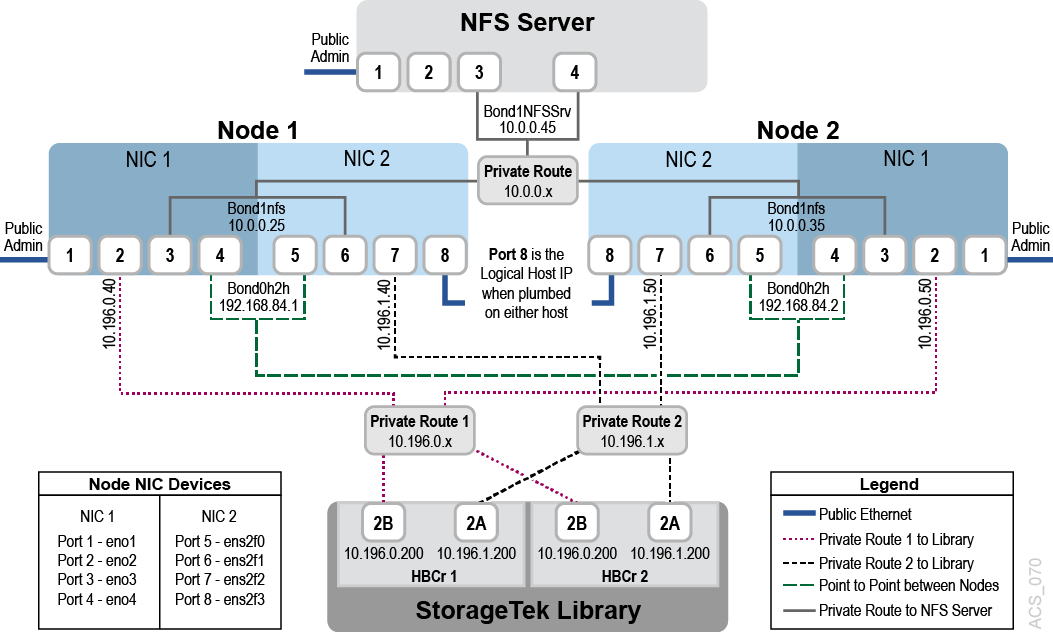Multipath Bonded Network Configuration
Redundancy is the overall scheme for high-availability computing. Redundancy applies not only to the servers, but to each communication interface on each server. For the public interface, use Internet Protocol Bonding on Linux. Internet Protocol Bonding provides instant NIC recovery for failing network communications without the need for a general system failover. For the library interface, this means using a dual TCP/IP connection with two network interfaces across two independent routes. If any element in one route should fail, ACSLS continues to communicate over the alternate interface. Note that if both paths to the library interfaces fail at the same time, ACSLS HA will not fail over to the other node. This behavior protects the integrity of other ACSs that may also be controlled by the instance of ACSLS under the control of ACSLS HA.
- Public and client communications
- Library communications
- Private intra-node cluster communications
- NFS communications
Port Mapping
Figure 2-1 shows eight Ethernet ports on each server, accessible from two separate Network Interface Controllers (four ports on each). A total of eight ports on each node are used.
- One cable for ACSLS-HA Logical Host connection for client access.
- Two cables for Library communications
- Two cables for direct Intra-node communications
- Two cables for NFS communications
- One cable for Public administration access.
Use Figure 2-1as a guide.
Note:
- Each port of each pair for the direct intra-node and NFS connections must reside on a different network interface card (NIC). This ensures that each NIC is not a single point of failure when the connections are bonded.
- The naming conventions used for the ports (eno1, ens2fo) in this guide may differ from your environment if your servers are of a different brand or model than used by Oracle and/or if you have installed external ethernet cards that use a different naming convention. If they differ then you will have adjust your configuration commands accordingly. It is strongly recommended that your ethernet cards and motherboard ports are named (device name) exactly the same.
- The IP addresses, bondings, and other networking configuration parameters in the examples provided in this publication coincide with Figure 2-1 and are used as if you are configuring the environment in this diagram. You must adjust accordingly for the private routes, IP addresses and other networking parameters in your environment.
- Each network device (port) has an associated configuration file named
ifcfg-interfacein the/etc/sysconfig/network-scriptsdirectory, where X-interface is the name of the interface. The names of your ports may differ from this if you are using a different server brand. You must have identical ethernet cards installed in each system. - Configuration files
ifcfg-eno1throughifcfg-eno4belong to the first NIC card on the motherboard andifcfg-ens2f0throughifcfg-ens2f3belong to the installed NIC card.When configuring network connections and bonding with command line tools (
nmcli), use the name of the interface, the portion of the configuration file name that followsifcfg-. For example, the interface name forifcfg-eno1iseno1. - Port 1 on each host in the diagram is the interface that you defined when you first installed the operating system.
Note:
Refer to the Oracle Linux 7 Administration Guide for more information about network configuration.